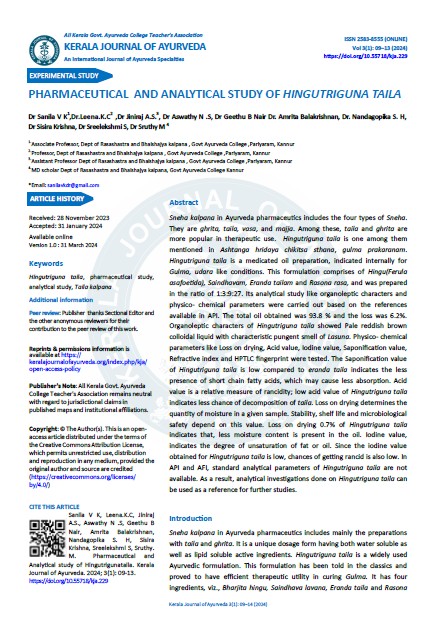PHARMACEUTICAL AND ANALYTICAL STUDY OF HINGUTRIGUNA TAILA
DOI:
https://doi.org/10.55718/kja.229Keywords:
Hingutriguna taila, pharmaceutical study, analytical study, Taila kalpanaAbstract
Sneha kalpana in Ayurveda pharmaceutics includes the four types of Sneha. They are ghrita, taila, vasa, and majja. Among these, taila and ghrita are more popular in therapeutic use. A number of Taila kalpanas have been mentioned in Ayurveda. Hingutriguna taila is one among them mentioned in Ashtanga hridaya chikitsa sthana, gulma prakaranam. Hingutriguna taila is a medicated oil preparation, indicated internally for Gulma, udara like conditions. This formulation comprises of Hingu, Saindhavam, Eranda tailam and Rasona rasa, and was prepared in the ratio of 1:3:9:27. Its analytical study like organoleptic characters and physico- chemical parameters were carried out based on the references available in API. The total oil obtained was 93.8 % and the loss was 6.2%. Organoleptic characters of Hingutriguna taila showed Pale reddish brown colloidal liquid with characteristic pungent smell of Lasuna. Physico- chemical parameters like Loss on drying, Acid value, Iodine value, Saponification value, Refractive index and HPTLC fingerprint were tested. The Saponification value of Hingutriguna taila is low compared to eranda taila indicates the less presence of short chain fatty acids, which may cause less absorption. Acid value is a relative measure of rancidity; low acid value of Hingutriguna taila indicates less chance of decomposition of taila. Loss on drying determines the quantity of moisture in a given sample. Stability, shelf life and microbiological safety depend on this value. Loss on drying 0.7% of Hingutriguna taila indicates that, less moisture content is present in the oil. Iodine value, indicates the degree of unsaturation of fat or oil. Since the iodine value obtained for Hingutriguna taila is low, chances of getting rancid is also low. In API and AFI, standard analytical parameters of Hingutriguna taila are not accessible. As a result, analytical investigations done on Hingutriguna taila can be used as a reference for further studies.
Sneha kalpana in Ayurveda pharmaceutics includes the four types of Sneha. They are ghrita, taila, vasa, and majja. Among these, taila and ghrita are more popular in therapeutic use. A number of Taila kalpanas have been mentioned in Ayurveda. Hingutriguna taila is one among them mentioned in Ashtanga hridaya chikitsa sthana, gulma prakaranam. Hingutriguna taila is a medicated oil preparation, indicated internally for Gulma, udara like conditions. This formulation comprises of Hingu, Saindhavam, Eranda tailam and Rasona rasa, and was prepared in the ratio of 1:3:9:27. Its analytical study like organoleptic characters and physico- chemical parameters were carried out based on the references available in API. The total oil obtained was 93.8 % and the loss was 6.2%. Organoleptic characters of Hingutriguna taila showed Pale reddish brown colloidal liquid with characteristic pungent smell of Lasuna. Physico- chemical parameters like Loss on drying, Acid value, Iodine value, Saponification value, Refractive index and HPTLC fingerprint were tested. The Saponification value of Hingutriguna taila is low compared to eranda taila indicates the less presence of short chain fatty acids, which may cause less absorption. Acid value is a relative measure of rancidity; low acid value of Hingutriguna taila indicates less chance of decomposition of taila. Loss on drying determines the quantity of moisture in a given sample. Stability, shelf life and microbiological safety depend on this value. Loss on drying 0.7% of Hingutriguna taila indicates that, less moisture content is present in the oil. Iodine value, indicates the degree of unsaturation of fat or oil. Since the iodine value obtained for Hingutriguna taila is low, chances of getting rancid is also low. In API and AFI, standard analytical parameters of Hingutriguna taila are not accessible. As a result, analytical investigations done on Hingutriguna taila can be used as a reference for further studies.
References
R.K. Sharma and Bhagwan Dash, Charaka Samhita, Vol I Sutrasthana, Reprint 2018, Chowkhambha Sanskrit Series Office Varanasi, Ch – 25/40, P – 426.
Prof. K.R. Srikantha Murthy, Vagbhata’s Ashtanga Hridayam, Vol II Chikitsasthana, Reprint 2014, Choukhambha Krishnadas Academy, Ch – 14/39, P – 407.
V.M. Kuttikrishna Menon, Kriyakaumudi, ed 1986, India Press Kottayam, Annexure 2, P – 854.
Dr.Brahmanand Tripathi,Sarangadhara Samhita ,ed 1990,Chaukhamba subharati Prakashan,Varanasi,Madhyamakhanda pg no:168
Dept of AYUSH ,Ministry of Health and Family Welfare Gpvt of India ,The Ayurvedic Pharmacopoeia of India first edition ,part 2,vol 2,appendix 2,The controller of publications,civil lines ,New Delhi, page 161.
Dept of AYUSH ,Ministry of Health and Family Welfare Gpvt of India ,The Ayurvedic Pharmacopoeia of India first edition ,part 2,vol 2,appendix 3,The controller of publications,civil lines ,New Delhi, page 221.
Dept of AYUSH ,Ministry of Health and Family Welfare Gpvt of India ,The Ayurvedic Pharmacopoeia of India first edition ,part 2,vol 2,appendix 3,The controller of publications,civil lines ,New Delhi, page 223.
Dept of AYUSH ,Ministry of Health and Family Welfare Gpvt of India ,The Ayurvedic Pharmacopoeia of India first edition ,part 2,vol 2,appendix 3,The controller of publications,civil lines ,New Delhi, page 222..
Dept of AYUSH ,Ministry of Health and Family Welfare Gpvt of India ,The Ayurvedic Pharmacopoeia of India first edition ,part 2,vol 2,appendix 3,The controller of publications,civil lines ,New Delhi, page 212..
Kandula Thanuja Reddy etal,Qualitative analysis of marketed castor oil according to Indian pharmacopiea and FSSAI ,World journal of Pharmaceutical research ,vol-8,issue 7,may 2019





